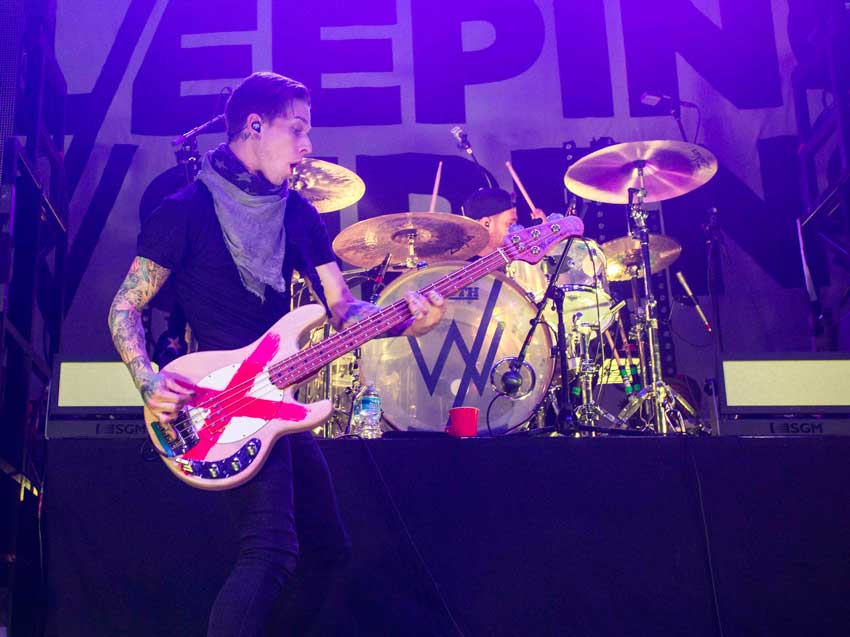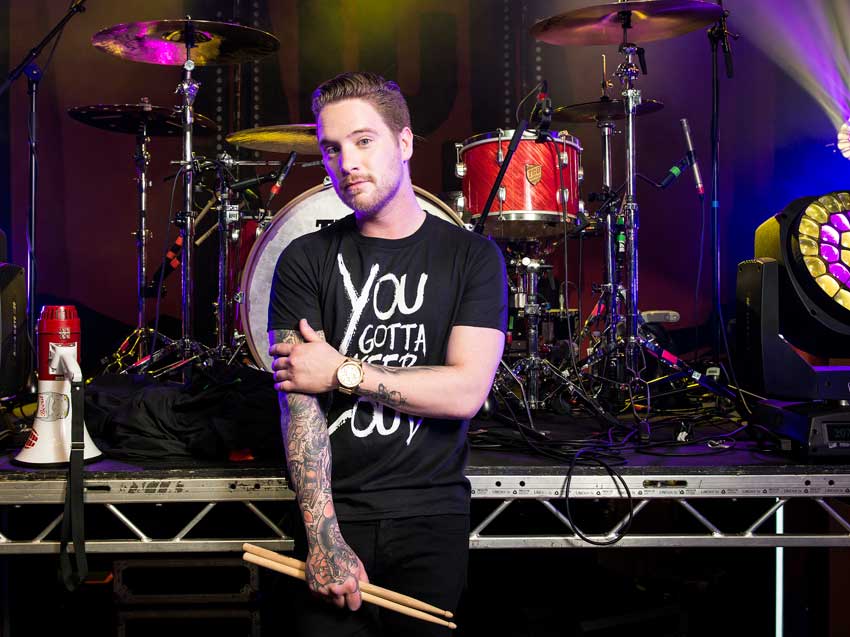Sleeping With Sirens' Gabe Barham
The Sleeping With Sirens, man reveals his approach to groove and why singer Kellin keeps attacking his drums

Gabe Barham
Gabe Barham started playing with vocalist Kellin Quinn and bassist Justin Hills in the band For All We Know, before they formed Sleeping With Sirens in 2009. They released their debut, With Ears To See And Eyes To Hear in 2010 and built their following with relentless touring.
Their third album, Feel, hit Number 3 in the Billboard charts in the US and they’ve just
released their fourth album, Madness, as their sound has evolved from the post-hardcore of
their early releases towards a more radio-friendly, emo vibe.
Here Gabe tells us about his ghost-note approach to groove, why lead vocalist Kellin attacks his drumset and keeping the rust off his technique while touring.

Keeping it simple…
“We were a little bit heavier on the first couple of records, a lot more double kick, a lot more over-the-top drum fills where the newer stuff has become more poppy. In worship band at church, the popular term is ‘less is more’. That’s one of the hardest things to do.
"I’m behind my drumset, the song is building up and I’m feeling I want to do this massive fill but sometimes just keeping it simple is the best, especially to make the drums fit the music in a tasteful way. But at the same time, I want to play parts like, ‘Oh, that was a nice drum fill,’ or, ‘That was a nice drum part, nicely placed.’ This new record, I love these songs. ‘Kick Me’ is really fun to play. ‘Go Go Go’ is fun to play, ‘We Like It Loud’… ‘Parasites’ is really fun to play too.

Working with demanding producers…
“We did a record in Nashville that we didn’t end up releasing, with Nick Raskulinecz who did Foo Fighters, Deftones, Alice In Chains. He was fun to record with. Well, I hated recording with him. I’m the type that I can go in the studio and do the whole song in one take, nail it. I’d do that, he’s like, ‘That was good, give it to me again.’ I do it again, I’m sweating by take two, he’s telling me, ‘All right, play harder.’ I’m playing as hard as I can. My hands are blistered up, bleeding.
"He would have me do each song like 20, 30 times. He wouldn’t be like, ‘This one part was a little off, can you do this one part?’ He’d be like, ‘Do the whole song again.’ I’m like, ‘Dude, you’re killing me!’ It was cool recording with him though, because he’s worked with Dave Grohl a bunch. I’d do some fill or some certain drum part, he’d pull out his phone and start recording, ‘I’m sending this to Dave, this is sick. What you’re doing is awesome.’ I’m nervous, ‘Stop filming me! He’s going to think it sucks!’ I was to the point where I had to get gloves. I’m like, I’m not wearing drumming gloves. He’s like, ‘Dave does when he comes in the studio.’ Alright, if Dave does, I guess it’s good.”

Keeping the groove…
“Playing a lot of ghost notes]. I feel like they help with the groove. Even though we’re playing to a click I feel like it helps me stay in the pocket. It might look a little fancy but I guess most people don’t notice. It feels natural. If I don’t do it, if I’m riding with my right hand and my right foot’s going, what is my left hand doing? Just sitting there, so I’ve got to do something with it.
"One song in particular where I do a lot of ghost notes is ‘Congratulations’. Jack has a guitar solo and that whole part is filled with ghost notes, my left hand is going the whole time. But it’s not too much. I can’t do blast beats and stuff like that, I’ve tried, but I can have my left hand going with ghost notes all day.”

Dealing with a mercurial lead singer…
“Sometimes Kellin [Quinn, vocals] will get mad because the cymbals are too loud and I play hard. He’s like, ‘All I can hear is your drums!’ He’ll come up and start ripping my drumset down, ripping cymbals down off the drum riser and throwing them, which makes me nervous – my drum tech even more! My drum tech is freaking out, having a heart attack.”

Locking in…
“It depends on how the song comes together. There is one song in particular called ‘Trophy Father Trophy Son’, that’s in 6/8, in the chorus, he [Justin Hills, bassist] just stares at my kick drum. We’re locked. It depends on the feel of the song and how the song comes together. I can follow the rhythm guitar but I like playing with the bass. You’ve got that rhythm section locked. If the drums and bass are locked, we can carry the song. The guitar can go out and we can hold it down. I’m going to say I like to stick with the bass.”

Evolving his playing…
“As far as this band goes, I’m pretty sure playing the actual parts aren’t going to be more complicated than any of our old stuff. It’s probably going to be pretty straightforward so the most I can do as far as making our shows better is just performance, putting on a good show while playing. Being entertaining to watch.
"As far as the technical side, I really want to get back into jazz. Tony Royster Jr crushes it. Ilan Rubin, he’s a crusher. Ambidextrous, he can go from his left hand to his right hand and actually when I’m home I like to practise that. I’ll try to take one of our songs and play it leading with my left. It’s challenging. Sometimes I’ll try to lead with my left foot too and it’s not easy but if I can get to be more ambidextrous, more independent with each limb, that would be cool. It just takes a lot of work.”

Keeping The Rust Off
"I have a kick pad where I set up my pedals and a practice pad on a snare stand and I’ll just practice rudiments and stuff with my feet. I really enjoy putting on hip-hop records and making up my own drums to them. The guys will get really mad at me because it’s loud and I’m in the green room being obnoxious, but that’s what I have to do otherwise I’m playing the same songs every night, not getting any better.
"When I’m home, I’ve got the Remo Silent Strokes on one of my kits and the Zildjian Gen-16 cymbals, they feel like real cymbals but they’re not loud. I can be jamming away and if the door is shut you can barely hear it in the next room. It’s not easy to practise on the road, but you’ve got to do it, you’ve got to stay fresh.
